Create
Vintage St. Pete: The Earl Gresh Wood Parade
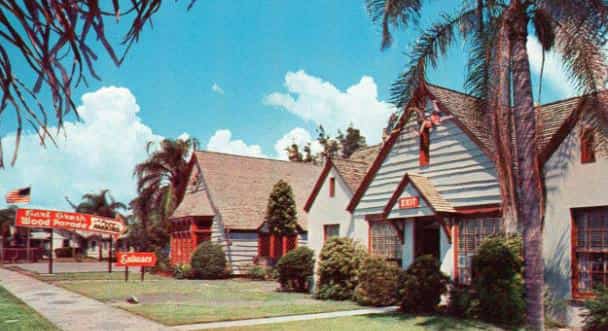
Visit the world’s most unique museum … Thrill to amazing artistry and craftsmanship in rare woods – magnificent murals, furniture, clever and unusual gifts. Pay a visit to pleasure you’ll profit by …
Florida Speaks magazine ad, 1951
The announcement in 2020 that the St. Petersburg Melting Pot fondue restaurant had closed for good led, perhaps inevitably, to a closer examination of the quaint, English cottage-style building that housed the fondue restaurant for 32 years, and its place in St. Pete history.
Before the Melting Pot moved into 2221 4th Street North in 1988, it was the home – for about 11 months – to a restaurant called Iggy’s Place. Prior to that, it was briefly called the Stateside Restaurant.

Rollande et Pierre
Many will remember it as Rollande et Pierre, the fancy French eatery owned and operated by Rollande Lohrer and her husband Peter, a.k.a. Pierre. Rollande et Pierre was at that 4th Street address between 1959 and 1985.
Although it’s been renovated, restored and re-fitted numerous times, the unusual three-building compound was built from scratch in the 1930s by Earl Gresh, a colorful St. Petersburg figure who first achieved fame as an orchestra leader, then as a racing boat champion, a trophy-winning fisherman and – in those bully years between the world wars – a renowned woodcarver and craftsman.
 Earl Gresh’s Wood Parade – a combination museum, workshop and gift shop – was a top St. Petersburg attraction for 20 years. It was featured in national magazines, on radio and on TV, and in promotional material aimed at attracting tourists to the area, alongside sparkling sunny beaches, juicy oranges – and Sunken Gardens, which was just a few blocks away. There were postcards, too.
Earl Gresh’s Wood Parade – a combination museum, workshop and gift shop – was a top St. Petersburg attraction for 20 years. It was featured in national magazines, on radio and on TV, and in promotional material aimed at attracting tourists to the area, alongside sparkling sunny beaches, juicy oranges – and Sunken Gardens, which was just a few blocks away. There were postcards, too.
The Wood Parade museum opened on Jan. 13, 1940. Admission was 25 cents. “Contains the most varied and complete collection of woods ever assembled,” proclaimed the advertisement in that morning’s St. Petersburg Times. “There are panels of representative woods from almost every part of the world – from Asia, Africa, Europe, Australia and the Americas.”
From the handout brochure:
The architecture of Kent, England was chosen for the main building because it offers the best opportunity for displaying the work of wood crafttsman (sic). The building with its mullioned windows is fashioned of longleaf pine timbers with flitch tide-red cypress siding. The rived shingles of heart cypress are similar to those originally used on George Washington’s home, Mount Vernon. Bricks from historic Fort Dade at the mouth of Tampa Bay were used for the garden wall and the immense chimney. The art of the handcraftsman is manifest in every detail of the exterior and interior of the building.
The centerpiece of the museum was a cross-section of an ancient cypress tree; weighing three tons, and measuring 11 feet across at the base, Gresh claimed the wood was 3,000 years old. The tree had been cut down in 1904 near Shamrock, in Dixie County.
He had carved small people, historical figures from across the centuries, and inserted them into the tree-ring timeline.
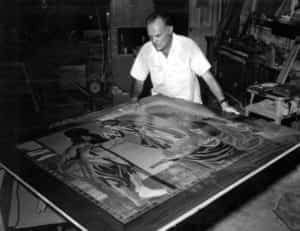
Gresh at work on the “Life of Christ” murals. Photo: Florida Memory Project.
Yet the real attraction was Gresh himself. He had already made his name as a woodcarver, creating buttons, bracelets, belt buckles, tackle boxes and fishing lures out of his cramped homemade workshop on the 4th Street property. He began to craft ladies’ handbags out of soft woods (with cloth interior), and the Earl Gresh Original Wood Purse – patented in 1943 – caught on, selling thousands via mail order.
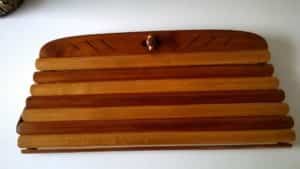
A Gresh purse
Visitors came from all corners to view Gresh’s hand-carved “paintings in wood” depicting, in more than a dozen separate scenes, the Life of Christ. Using the inlay technique known as marquetry, Gresh created the complex 5×5 foot murals, utilizing 62 different woods, over a span of 17 years.
Man of many talents
Earl Parker Gresh had become fascinated with carving soft woods while working at his father’s cigar factory in Bordentown, N.J.; he was hypnotized, he always said, by the aromatic smell of the cedar used for cigar boxes. Earl was an ambitious kid – at his Military Prep academy, he mastered the violin and led the school dance band.
In 1911, when he was 15, he moved with his widowed mother to St. Petersburg.
After a stint in the Navy during World War I, he returned to St. Pete … and fate intervened.
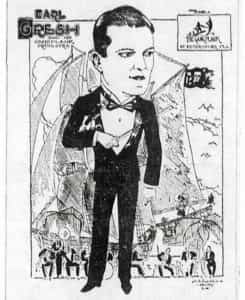 “One night by the old wooden pier, I ran into these six boys from Kentucky State College who had an orchestra,” he recalled to Times columnist Dick Bothwell years later. “I told them I played the fiddle …”
“One night by the old wooden pier, I ran into these six boys from Kentucky State College who had an orchestra,” he recalled to Times columnist Dick Bothwell years later. “I told them I played the fiddle …”
Soon, the smooth-talking violinist was the Kentucky Kernels’ bandleader. A regular booking at the Park Street speakeasy the Gangplank – in the area now known as Jungle Prada – gave the group its new name: Earl Gresh and the Gangplank Orchestra. St. Petersburg’s first radio station, WJBB (later WSUN), broadcast several hours every week from the Gangplank, and from the neighboring Jungle Hotel. Gresh, through this association, because the station’s first announcer.
The group was also the favored dance band at the Gold Dragon nightclub, high above Rutland’s Department Store at 5th and Central.
 Between 1924 and 1927, Earl Gresh and His Gangplank Orchestra cut more than a dozen 78s for Columbia Records; this allowed them to tour the country, which they did, until Gresh’s wife – home in St. Pete raising their two young sons – insisted he put a stop to it.
Between 1924 and 1927, Earl Gresh and His Gangplank Orchestra cut more than a dozen 78s for Columbia Records; this allowed them to tour the country, which they did, until Gresh’s wife – home in St. Pete raising their two young sons – insisted he put a stop to it.
He put a stop to it.
Restless at home, Gresh turned to boat motor repair, and then to boat racing. He carved and cured wood to create sleek hulls, which, when motorized, sliced through the waters of Tampa Bay at lightning speeds. A Times article dated Jan. 3, 1931 describes him as a “daredevil,” entertaining visitors to the downtown pier in his speedboat Hurricane.
Gresh became a national champion speedboat racer after winning 42 consecutive races in the 1929-30 season.
This, unfortunately, dovetailed with the Great Depression, and the boatbuilding and racing businesses stopped paying. So he began to fine-tune his woodworking skills. “Great-grandfather was a wonderful woodworker,” Gresh would tell Bothwell. “Grandfather built his home and all of his furniture in Hutchinson, Kansas.”
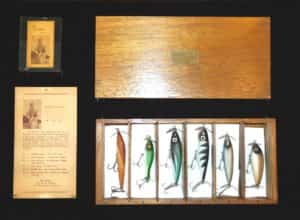 Fishing was Gresh’s true love (second only to Marian, his devoted wife). He made and sold custom lures and carved compartmentalized tackle boxes by hand. He fished every river, lake, trout stream, bay, gulf and estuary in the United States. He ran into President Herbert Hoover at Yellowstone National Park – both were there in search of trout in the Madison River.
Fishing was Gresh’s true love (second only to Marian, his devoted wife). He made and sold custom lures and carved compartmentalized tackle boxes by hand. He fished every river, lake, trout stream, bay, gulf and estuary in the United States. He ran into President Herbert Hoover at Yellowstone National Park – both were there in search of trout in the Madison River.
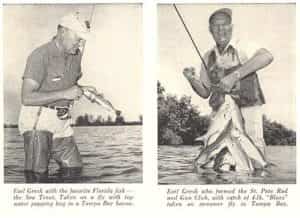
Florida Speaks magazine, 1951. For a time, Gresh was fishing editor.
Gresh taught the president how to tie his own flies, and continued to send him Gresh-made lures for years afterwards. He even made a special tackle box for Hoover. He did the same for Dwight D. Eisenhower, after First Lady Mamie wrote him a personal letter requesting one for her husband.
He founded the local Rod and Gun Club, and was the president of the Propeller Club, and was one of the driving forces behind the Suncoast Tarpon Roundup – the now 85-year-old organization still hands out the Earl Gresh Sportsmanship Award.
End of the Parade
The ribbon was cut July 19, 1955 on the last Pinellas County stretch of U.S. 19, connecting south and north. This was the death knell for most tourist-dependent businesses on 4th Street, as the traffic coming in over Gandy Bridge – or the newly-erected Sunshine Skyway Bridge – was now diverted to the highway.
The Earl Gresh Wood Parade was a casualty of progress.
“This is the end of an era,” Gresh said in a newspaper interview. “People don’t come in … it’s my hope that some group of businessmen will take over the Wood Parade for exhibit on U.S. 19.”
He was asked what he was planning for his “retirement” phase. “I’m interested in testing and evaluating fishing tackle, boats and outboard motors,” Gresh replied. “I’m fishing twice a week – wonderful medicine. And I’m designing a set of top water bass bugs for a national manufacturer.”
 On May 4, 1958, the contents of the Earl Gresh Wood Parade were sold at auction. Gresh donated the “Life of Christ” murals to Memorial Park, the cemetery and mausoleum on 49th Street North, where they are still on display today, inside the Christ Chapel.
On May 4, 1958, the contents of the Earl Gresh Wood Parade were sold at auction. Gresh donated the “Life of Christ” murals to Memorial Park, the cemetery and mausoleum on 49th Street North, where they are still on display today, inside the Christ Chapel.
Rollande et Pierre moved into the 4th Street property in early 1959.
Marian, Gresh’s wife of 55 years, died in 1969. That same year, two of their three sons suffered fatal heart attacks.
“I was lost, but I didn’t let it get me down,” he said. “I believe every day is a new venture, something to look forward to. I’m privileged to be on this earth.”
Earl Gresh died June 30, 1977. He was 81.
Writer Jeff Klinkenberg, just a few months into what would become a nearly 40-year career at the Times, conducted the last interview with the legendary jack-of-all-trades.
He made it clear what activity had clearly meant the most to him, from his long life and multiple careers.
“Don’t write a history of Earl Gresh,” the old man, suffering from severe arthritis, said to the young reporter. “Don’t. But say this … here’s how to begin the article. ‘With Earl Gresh, fishing was a way of life.’
“It really was, you know.”
This story appears in the book Vintage St. Pete: The Golden Age of Tourism – and More (St. Petersburg Press). Originally published in the St. Pete Catalyst April 2020.

The site today. The former Melting Pot restaurant is in the museum building at left; Earl Gresh’s hand-crafted chimney, made with Fort Dade bricks, is clearly visible. Photo by Bill DeYoung.

Detail, “Life of Christ” mural at Memorial Park in St. Petersburg. Earl and Marian Gresh are interred in this mausoleum/chapel. Photo by Bill DeYoung.


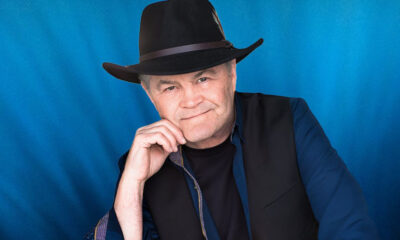





Larry Owen
May 24, 2022at12:19 pm
We still have my mother’s wooden purse she bought while working for Bromley’s Jewelry (Silverberg family). Memories!!